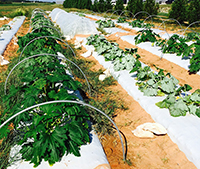Row covers, material used to protect plants from the cold and wind, can also protect squash from disease-carrying squash bugs and other insect pests, according to University of Georgia Cooperative Extension Plant Pathologist Elizabeth Little.
Squash bugs are a type of stink bug that feed only on cucurbit crops, mainly squash, pumpkins and watermelons. Squash bugs are sucking insects with piercing mouth parts that they insert into the phloem or xylem of the plant to feed. Phloem and xylem are vascular tissues that transport food, water and minerals from a plant’s roots to its leaves. When squash bugs feed, they spread the bacterial pathogen that causes cucurbit yellow vine disease (CYVD). If the plants are infected when they’re young, the disease will eventually cause the leaves to yellow, followed by wilt and plant collapse, usually at the time of first fruit set.
CYVD can wipe out an entire field of squash plants if squash bugs are present when the plants are young.
“I think once (the plant) yellows, they’re doomed. Within a week or so, the plant will collapse,” Little said. “I’ve seen entire squash plantings go down. It is alarming for the growers.”
Little’s research with CYVD targets organic producers, mostly located in the Georgia Piedmont region. Since organic farmers produce crops without using conventional insecticides, they need alternative means to manage destructive pests like squash bugs.
Little and her graduate students studied the use of floating row covers, made of a lightweight woven fabric that allows sunlight in but keeps insects out.
“We found that using row covers during the first four weeks of growth — if you implement this strategy as soon as you plant and seal the edges — will prevent the disease,” she said.
Row covers should be removed after four weeks so that the plants can be pollinated.
Squash bugs overwinter as adults in sheltered areas, such as under woody plant debris. They emerge in May and search for the first squash crop they can find.
Little believes that trap cropping can also be an effective means of preventing squash bug infestations. A trap crop is a host plant that attracts insect pests and gives the main crop extra protection. If the trap crop is planted before the main crop and near where squash bugs overwinter, the bugs will congregate on the trap crop as they emerge. This will keep most of the squash bugs off of later crops for a period of time.
One important consideration is that the bugs on the trap crop must be killed. Little said that some growers throw plastic over the plants and let the heat kill the bugs. Bug vacuums may be another option. Killing these first squash bugs prevents a second generation from forming and relocating to a later field of squash.
For more about controlling plant pests, contact your local UGA Extension agent at 1-800-ASK-UGA1.








